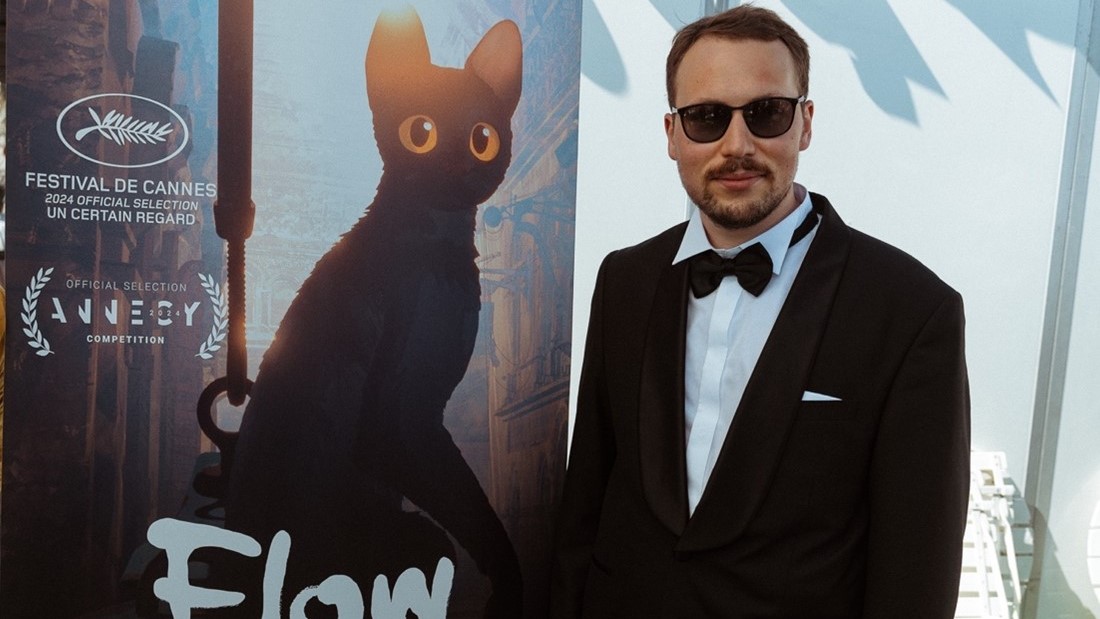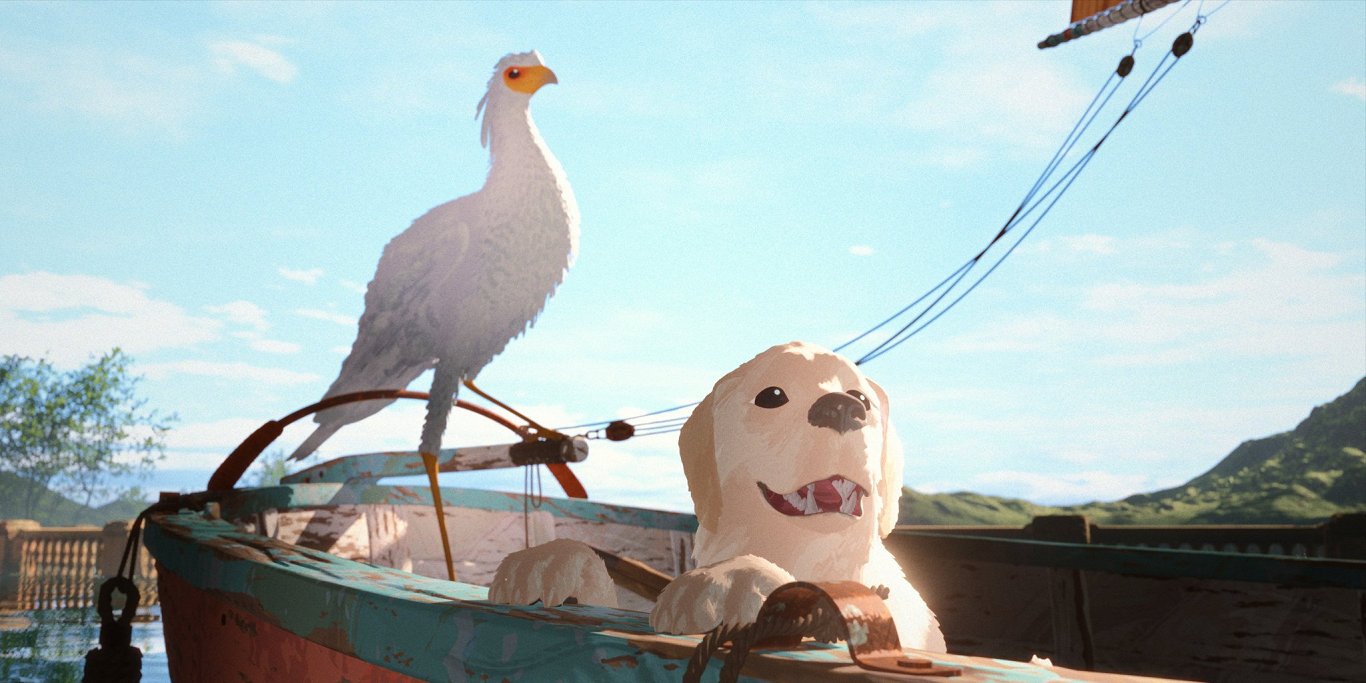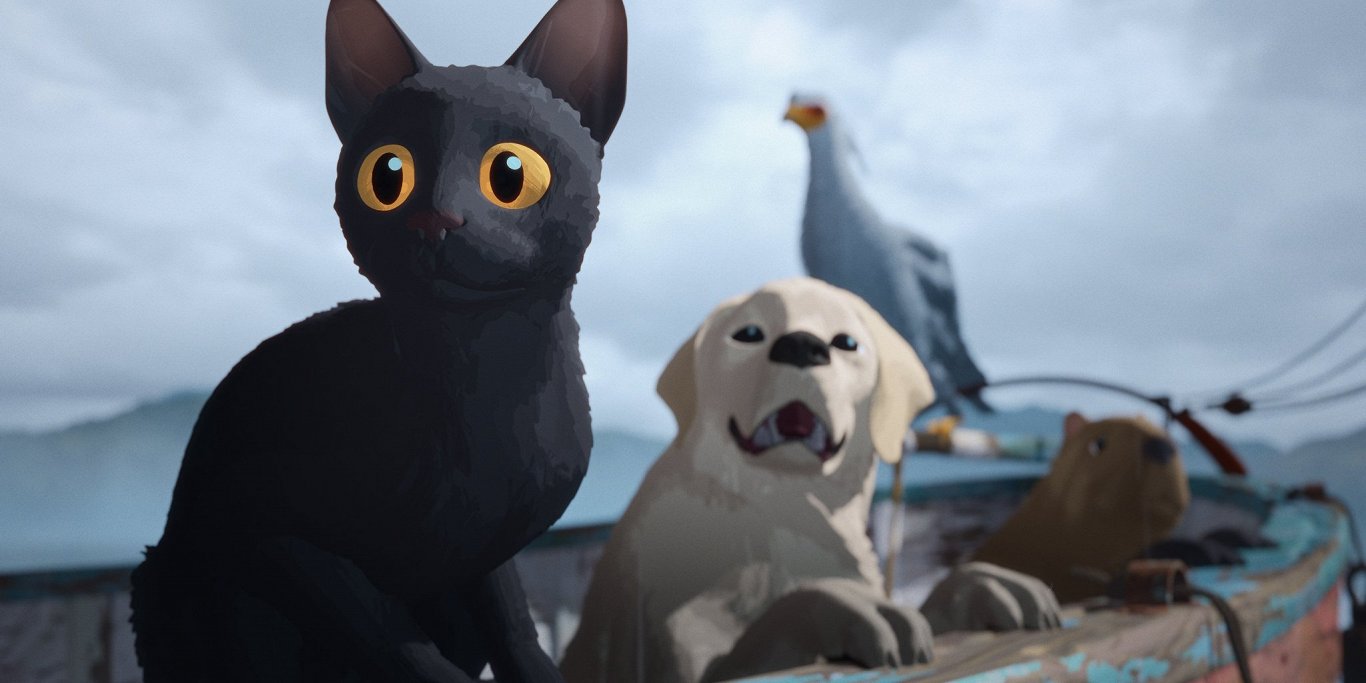Let's be honest. Latvian Academy Award competitors are usually put forward for form's sake rather than haboring any realistic expectations of making it to envelope-opening time. But 'Flow' is different. It has a real chance, and the reason, I think is this: it credits the audience with intelligence and imagination in addition to the virtues mentioned above.
In essence the story is simple: a black cat attempts to survive in a world in which the waters are (first suddenly, and then more gradually) rising. In doing so it must escape from various situations of jeopardy, including by means of a boat, and along the way encounters other creatures with which it forms various alliances.

The precis above could be used to imagine a film of the usual Disney/Pixar type in which highly anthropomorphised animals displaying extremely human sassy/streetwise/comedic traits have an adventure with a limp moral about friendship tacked on, plus the all-important hit song and huge merchandising opportunities. The kids want to see it as a result of a massive marketing campaign, the parents feel obliged to take their offspring and over the following days and weeks also feel obliged to purchase the lunchbox, the T-shirt, the slippers, the burger meal and so on. It's a sort of broad-ranging contract between an animation studio, a merchandising and distribution network and a billion families craving time together.
'Flow' is different in myriad ways, but the chief one is this: the audience is not served up the tried and trusted formula. The audience has to make an imaginative effort – individualy and collectively – to follow the film.
Most obviously this is because there is no dialogue at all – an extremely bold move that, remarkably, works perfectly. The cat does not make wisecracks. It does not state its long-held dreams. We do not get flashbacks to when it was separated from someone (animal relationships in the blockbuster movies are always human sentimentality by proxy). The cat's motivation is clearly to survive the imminent danger posed by the rising waters.
Early scenes are a bravura series of chases that establish both the filmmakers' total technical mastery and the more important information that in this movie the cat acts in a genuinely cat-like manner, not as a human soul in possession of a feline body. Dogs act with the movements, behavioral quirks and noises of dogs. Birds have that disconcerting, dinosaur-like inscrutability and potential for sudden action that can be quite terrifying when displayed on a giant screen.
Therefore, it is essential to watch the movements and actions of the protagonists and the astonishing environments in which they find themselves in order to work out what is happening, or at least, what you, the audience member, think is happening. It is perhaps the most extreme example of the old movie maxim "Show, don't tell" since the days of Buster Keaton, when audiences were adept at reading or imagining character motivation in a way that atrophied with the introduction of the talkies.

That's not to say 'Flow' is completely devoid of anthropomorphism – the cat does manage to steer a boat (after a fashion), and his sleepy capabara companion is on hand for regular doses of comic relief to counterbalance the tension of the perpetual peril in which the animals find themselves. But the difference is this: it is up to each audience member to 'humanise' the animals to the extent to which they find the action explicable.
So, younger members of the audience can happily dwell on the cuteness of eyes and mewing, or perhaps the resemblance of the central character to a cat they have at home, while older members of the audience might find themselves trying to resist similar impulses and lose themselves in the impressive landscapes of a drowned world that is every bit as surreal and compelling as the one imagined by J G Ballard or the 'Owl and the Pussycat' fable of Edward Lear.
Here I am at risk of sounding pretentious, so I shall dial my claims back and say more simply: 'Flow' credits the audience with a power of imagination equal to that of the filmmakers. That is a bigger risk and a bigger compliment than it sounds – and I think that is part of the reason why 'Flow' is winning standing ovations even from the cynical cinema critics.
In movies generally, and particularly in those that can play to kids (I refrain from calling this a kids' movie, as its appeal is much wider) we have got so used to being spoon-fed exposition, plot and character traits that to be presented with a film in which all of these things require us to pay attention and construct our own notion of what is happening and what will happen next is a bit like riding a bicycle after an interval of twenty years. You realise with a sense almost of of shock that you can still do it and that it still gives you the same joyous feeling as when you were a child.
It is churlish to pick holes in such a joyful experience as the 85 minutes of expanded imagination you will get from 'Flow' but I suppose I must. I have just two criticisms, both the result of me being an irritable middle aged person and therefore probably to be ignored. First, I got a bit tired of listening to mewing. Not to the extent that I wanted the cat to start talking and telling me what valuable lessons it had learned about friendship or global warming. No, I just wanted it to take a mewing time out.

Second – and this is a really niche criticism – I disliked the occasional intrusion of dust motes into the frame. This is not a case of obsessive/compulsive disorder, I swear. Swirling dust motes are a trick of the trade among animators – they insert a feeling of depth and movement into what would otherwise be a more static and flat frame. Chuck in a few drifting dust motes and it's instantly atmospheric, particularly if said dust motes are golden and moving left to right. Most of the time you don't even notice them. The trouble is, when you do, you're suddenly aware of being manipulated in a way that 'Flow' almost completely avoids otherwise (apart from a few instances of 'hand wobble camera' that make you think "Hang on, this is animation not hand-held cinema verite").
But in the final analysis, dust motes are an insignificant price to pay for an exhilarating imaginative experience you can share with your entire family. Don't take my word for it: another marvellous filmmaker, Guillermo del Toro said of 'Flow': "If I could wish for the future of animation, these images would be its magnificent, breathtaking start."
Let's hope he's right, because I for one am sick to death of sassy animals with attitude teaming up to learn banal lessons about friendship. It is surely only a matter of time before Zilbalodis and company are approached by the big studios with a proposal for a remake of 'Flow' featuring wisecraking, team-written dialogue voiced by Hollywood B-listers and an autotuned pop/rap soundtrack (if such an offer hasn't been made already). While it would be nice to imagine such an offer being rejected, one could hardly blame the creatives behind 'Flow' for accepting what are likely to be massive financial inducements. The resulting film would most likely be just another one along the Hollywood production line, but it wouldn't really matter. 'Flow' already exists and anyone with any imagination can already go and see it, so why wait for an inferior remake?


























